SUMMARY HIGHLIGHTS
- The Hiroshima Peace Memorial Museum is depressing. Prepare yourself.
- In my opinion, Hiroshima-style okonomiyaki is better than Osaka-style okonomiyaki. Hiroshima’s oysters are delicious as well.
- Miyajima Island is a must-visit.
Hiroshima surprised me. I didn’t expect to like it as much as I did.
I had visited Nagasaki a few years before my first trip to Hiroshima. Because of their shared histories, I expected a similar feeling of heaviness from Hiroshima, a sense of joylessness often felt in places with dark histories. But that wasn’t my experience at all.
Like many tourists, I was drawn to Hiroshima because of its unfortunate role in the war. Stepping foot in Peace Memorial Park will remind you of that. Peace Memorial Museum and the Atomic Bomb Dome are the city’s most famous attractions but as I would later learn, they’re hardly the only reasons you should visit Hiroshima.
From okonomiyaki better than Osaka’s to one of the three most celebrated views in Japan, stay long enough and you’ll realize there is so much more to Hiroshima than its tragic past.
VISIT HIROSHIMA QUICK LINKS
To help you with your Hiroshima trip planning, I’ve compiled links to recommended hotels, tours, and other travel-related services here.
HOTELS
Top-rated hotels in downtown Hiroshima, the most convenient area to stay for first-time visitors.
- Luxury: Sheraton Grand Hiroshima Hotel
- Midrange: HOTEL CLA-SS HIROSHIMA-TOKAICHI
- Budget: Capsule Hotel Cube Hiroshima
EXPERIENCES
- Sightseeing Tour: Hiroshima Peace Walking Tour at World Heritage Sites
- Food Tour: Hiroshima Bar Hopping Food Tour
- Cultural Experience: Artisanal Makeup Brush Crafting
- Miyajima Day Trip: Miyajima Half-day Trip Historical Walking Tour
- Cooking Class: Cooking Classes in Hiroshima
OTHER SERVICES
- Travel Insurance (non-US residents get 5% off)
- Airport Transfers
- Visit Hiroshima Tourist Pass
- Japan Rail Pass
- Japan eSIM
GUIDE TABLE OF CONTENTS
HIROSHIMA AT A GLANCE
Hiroshima is a former castle town that was an important center for military activity during the imperial era. It played significant roles in multiple wars, though none more remembered perhaps than the Second World War when it was the first of two Japanese cities targeted by a nuclear weapon. The second was Nagasaki.
About 70% of the city’s buildings were destroyed by the atomic bomb, but Hiroshima has since rebuilt itself to become the biggest city in the Chugoku region of western Honshu.
Today, the site of the nuclear attack is one of the top tourist destinations not just in Hiroshima, but in all of Japan. The same can be said about Itsukushima Shrine in Miyajima, a sacred island less than an hour southwest of central Hiroshima.
For centuries, the shrine’s floating torii gate has been regarded as one of the three most scenic views in Japan.
BEST TIME TO VISIT HIROSHIMA
Hiroshima enjoys a temperate climate so there’s really no bad time to visit. My last trip was in the middle of winter and I was perfectly fine with just a puffer jacket, even while hiking on Miyajima Island.
Hiroshima is a year-round destination but like many cities in Japan, spring and autumn are typically the best times to visit. Not only is the weather ideal, but you’ll get to enjoy the cherry blossoms in spring and the turning of the leaves in the fall. A hike in Miyajima would be even more spectacular in either season.
If you’d like to visit Hiroshima during a festival, then you’ll be pleased to learn that three big festivals are held in the city every year – Tokasan in June, Sumiyoshisan in July, and Ebessan in November.
WHERE TO STAY IN HIROSHIMA
If your main goal is to visit the main attractions in Hiroshima City, then it’s best to stay in the area immediately east of Hiroshima Peace Park.
This puts you close to the city’s top tourist attractions like the Atomic Bomb Dome, Hiroshima Peace Museum, Hiroshima Castle, and Shukkei-en Garden. You’ll also have your pick of the best restaurants and be close to many shopping malls and arcades.
You can search for hotel listings in downtown Hiroshima on Booking.com or Agoda. Here are some of the top-rated hotels in the area:
- Luxury: Sheraton Grand Hiroshima Hotel
- Midrange: HOTEL CLA-SS HIROSHIMA-TOKAICHI
- Budget: Capsule Hotel Cube Hiroshima
THINGS TO DO IN HIROSHIMA
Visit Peace Memorial Park & Museum
As described, the Peace Memorial Park and Museum are the most visited attractions in Hiroshima. The park occupies over 120,000 square meters of open space and features multiple monuments dedicated to the victims of the nuclear attack.
The most prominent structures at the park are the skeletal remains of the Atomic Bomb Dome. Despite being the closest building to the hypocenter, it was one of just a few structures that was left standing after the attack. You can see the building’s dome through the sculpture’s arch below.
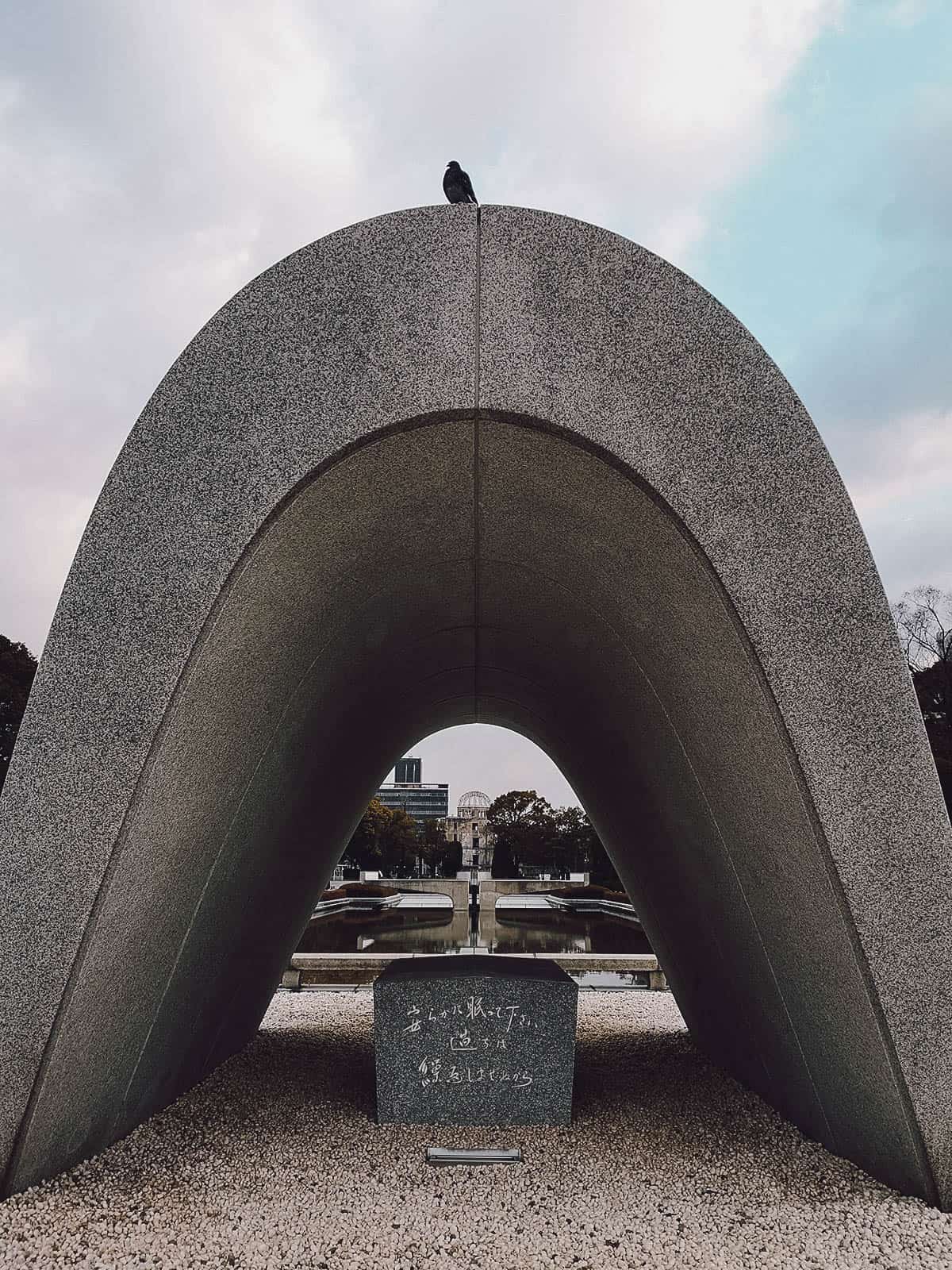
Opened in 1955, the Hiroshima Peace Memorial Museum consists of two buildings with exhibits recounting the events of the nuclear attack. It features items like toys and articles of clothing that survived the bombing, along with the human stories behind them.
I visited the Atomic Bomb Museum in Nagasaki a few years ago. Both museums are powerful but I found this one to be more emotionally charged. The museum in Nagasaki focuses on the events surrounding the bombing while the Hiroshima Peace Museum zeroes in on the human tragedy. It’s hard not to get teary-eyed while going through the exhibits.
I went to the museum on my own but if you’d like to go with a guide who can explain everything in more detail to you, then you may want to book a tour through Magical Trip.
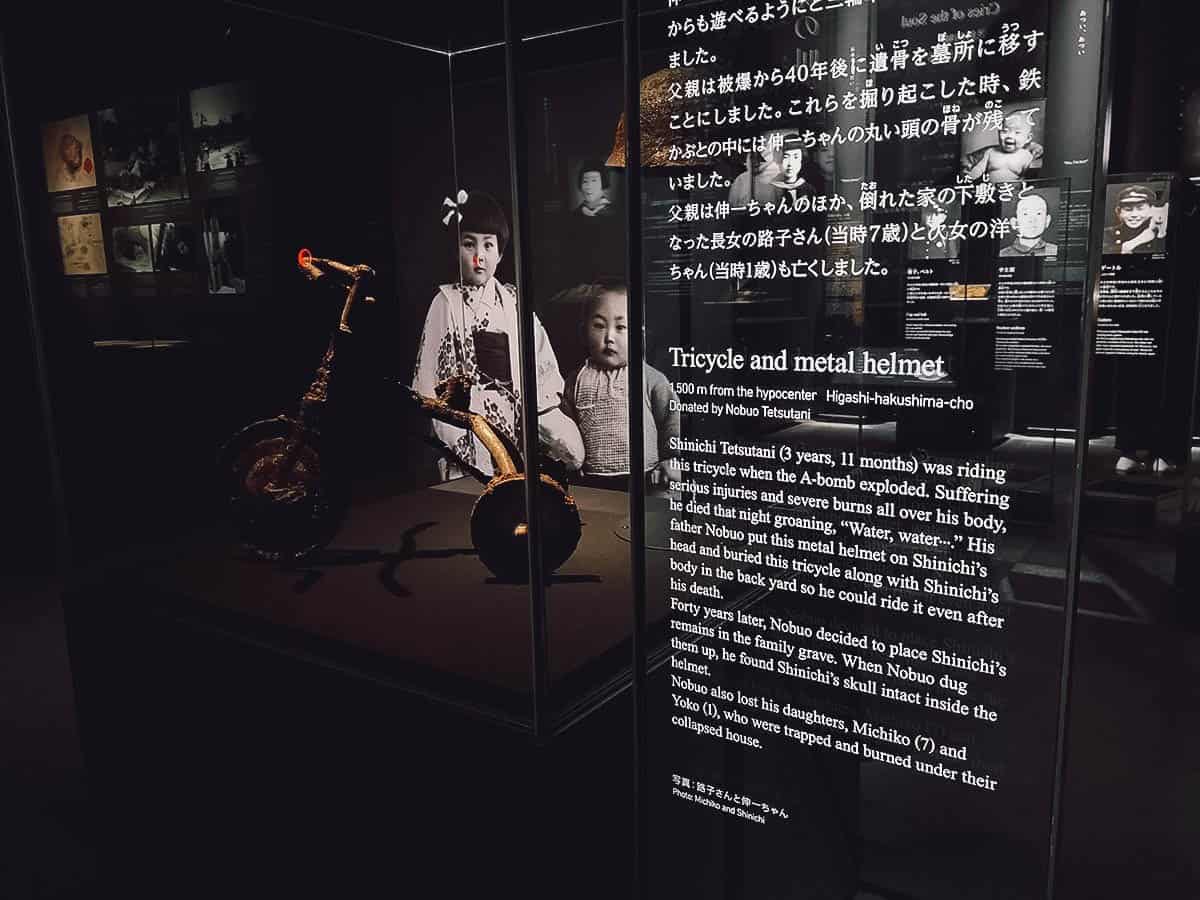
Enjoy the Atmosphere at Shukkei-en Garden
If you like Japanese landscaped gardens, then you’ll probably want to spend some time at Shukkei-en Garden. Located just east of Hiroshima Castle, it’s a medium-sized garden featuring a central pond with a rainbow bridge and multiple walking paths.
Shukkei-en isn’t as big as some of the more celebrated gardens in Japan, but it’s beautiful in its own right and a great place to spend an hour or so in Hiroshima. I visited the garden on my own but there are a few tours on Get Your Guide that make stops at Shukkei-en.
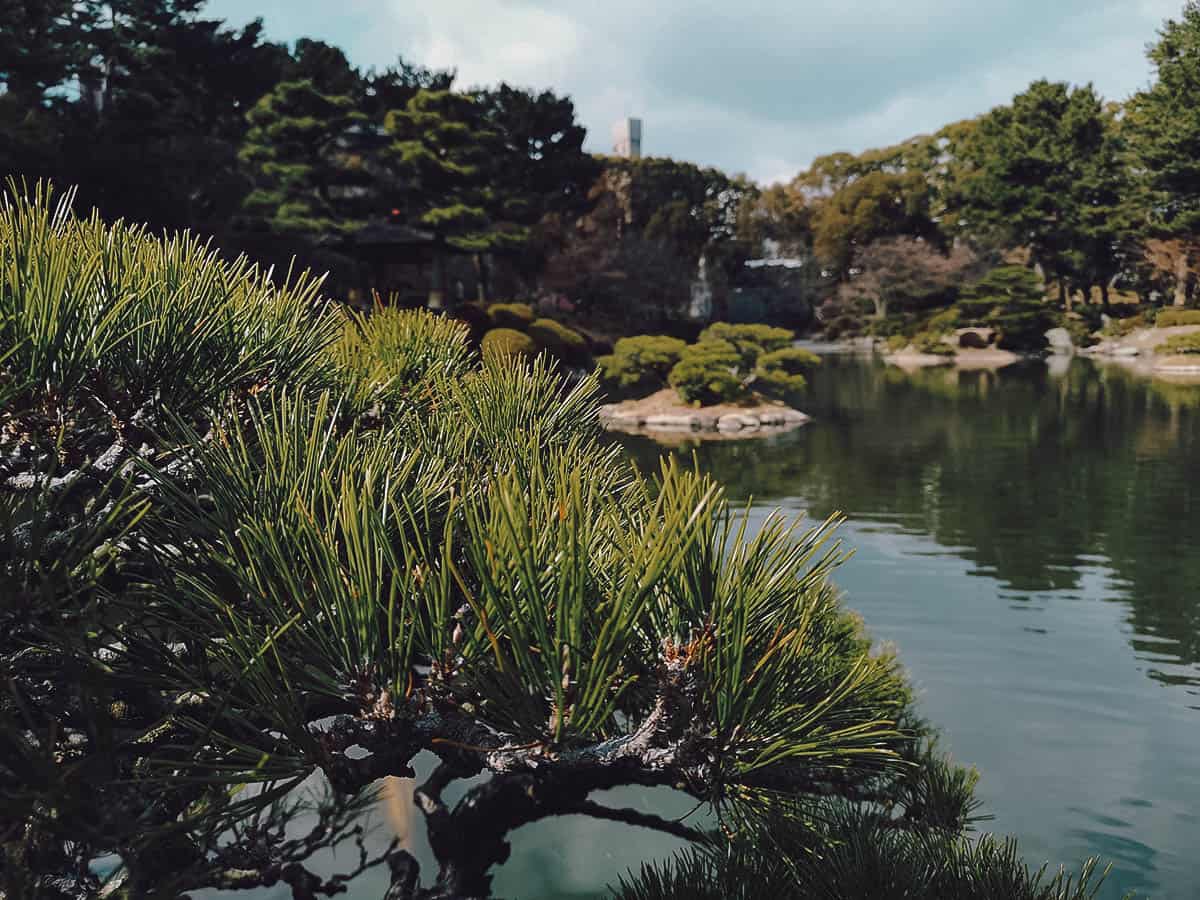
Try Hiroshima-style Okonomiyaki
Like Osaka, the one dish that Hiroshima is best known for is okonomiyaki. If you’ve never had it, it’s a Japanese savory-sweet pancake made with wheat flour batter mixed with eggs, grated yam, shredded cabbage, and other ingredients.
Osaka and Hiroshima okonomiyaki are slightly different versions of the same dish. Both are delicious but for me, Hiroshima-style okonomiyaki is better. Check out this Hiroshima food guide to learn more about the differences between the two.
There’s no shortage of okonomiyaki restaurants in Hiroshima, but if you’d like to try it with a local guide, then you may be interested in this bar hopping food tour.
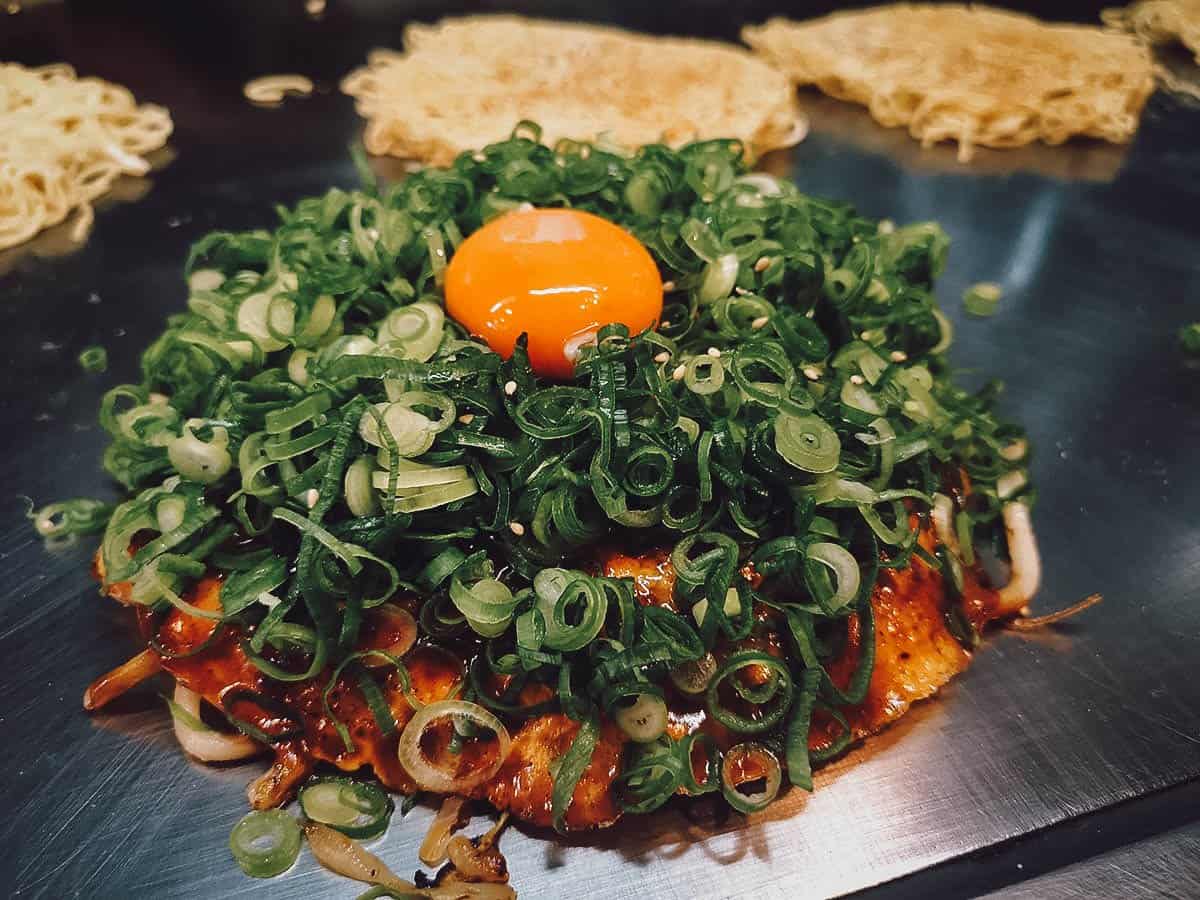
Make a Quick Stop at Hiroshima Castle
Hiroshima Castle will never be mentioned in any list of must-visit castles in Japan but I liked it. It isn’t nearly as grand as Himeji or as striking as Matsumoto but it has its own charm with its wooden exterior and tree-lined grounds surrounded by a moat.
I admired the castle from across the moat but visitors are welcome to explore the castle grounds and enter the main keep for a fee.

Visit the Mazda Museum
People who’ve been to Nagoya have probably visited the excellent Toyota Techno Museum. But did you know that Hiroshima has its own noteworthy automobile museum as well?
I didn’t know this but Hiroshima has been the home of the Mazda Motor Corporation since 1920. The company retains its corporate headquarters in the city and has opened a museum and part of its factory to the public.
Guided tours in English are available but they need to be reserved in advance. Walk-ins aren’t allowed so it’s important to reserve a slot a few weeks (even months) before your trip.
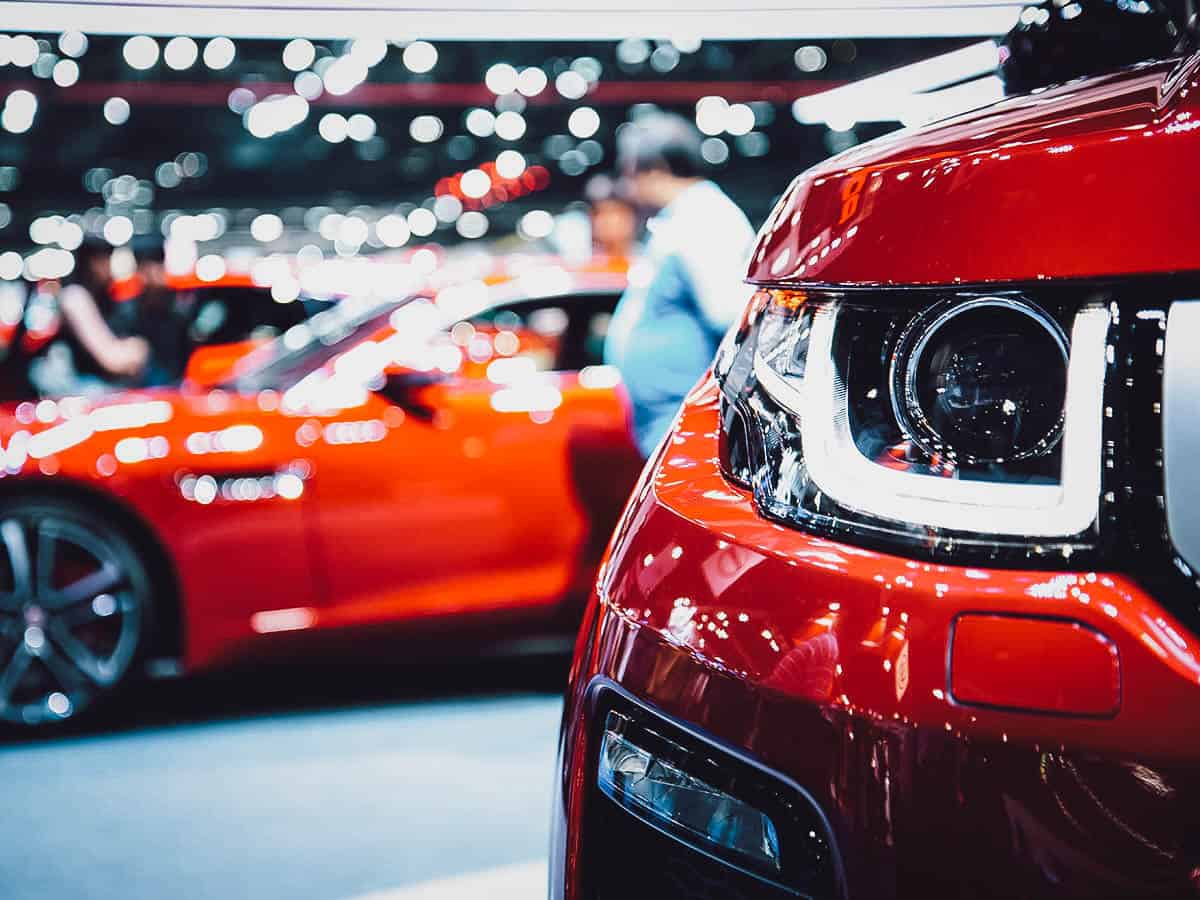
Photo by superoke via Shutterstock
Take a Cooking Class
If you love Japanese food and like to cook, then you may be interested in taking a cooking class. I haven’t taken one in Hiroshima but I did take a cooking class in Tokyo where I learned to make classic Japanese dishes like udon, tempura, and tamagoyaki. It was loads of fun.
Check out airKitchen for a list of cooking classes in Hiroshima.
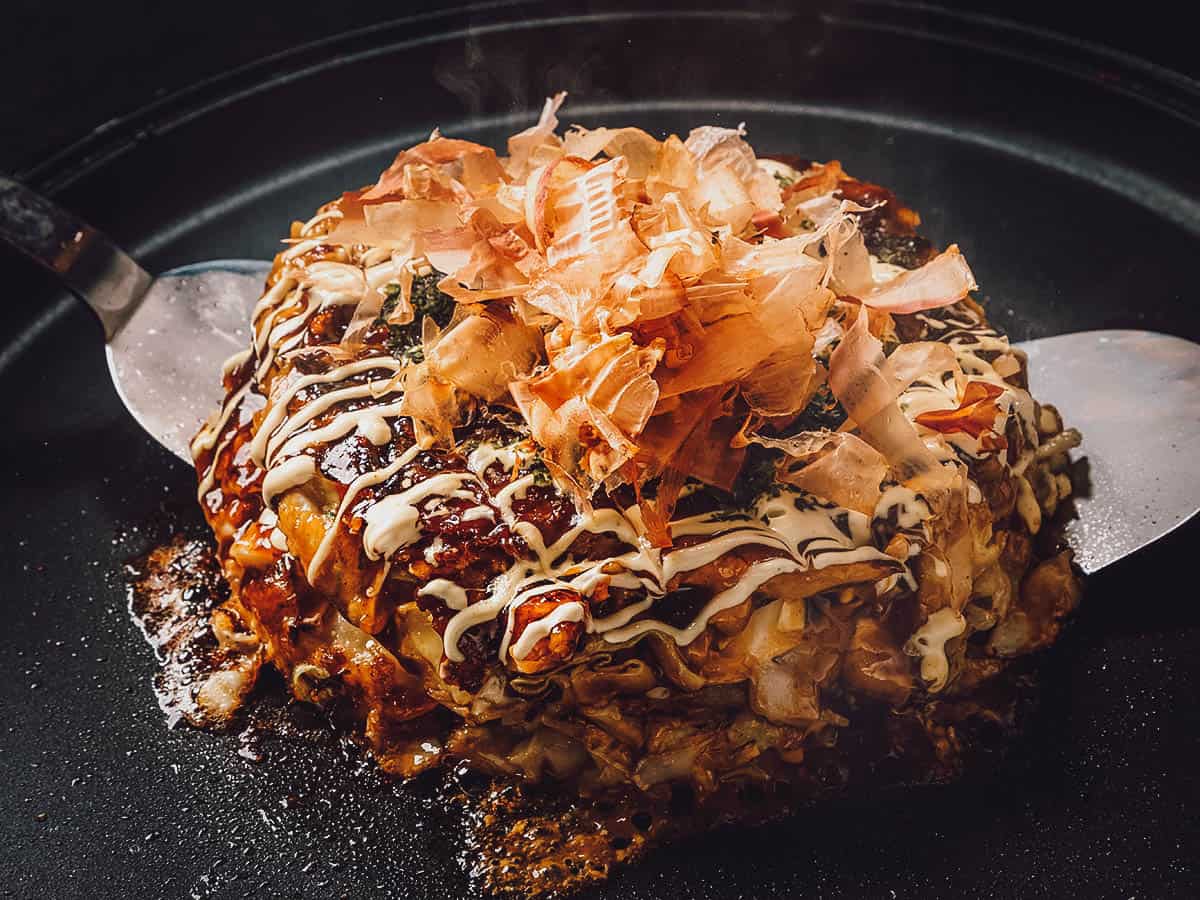
Photo by norikko via Shutterstock
DAY TRIPS FROM HIROSHIMA
Miyajima Island
I love Miyajima Island. Spending a day exploring this small sacred island is one of the best things you can do in Hiroshima.
Miyajima’s main draw is Itsukushima Shrine – a Shinto shrine and UNESCO World Heritage Site renowned for its large orange torii gate. Built over water, the gate gives the impression that it’s floating at sea during high tide. It’s a dramatic sight that’s long been considered one of Japan’s three most celebrated views.
But as impressive as the gate is, it’s hardly the only thing you can do on Miyajima Island. The island offers fantastic hiking opportunities to the summit of Mount Misen, not to mention some of the best and freshest oysters in Hiroshima.
Located less than an hour from the city center, it’s easy to explore Miyajima Island on your own. If you’d prefer to visit with a guide, then you may be interested in this half-day Miyajima walking tour.
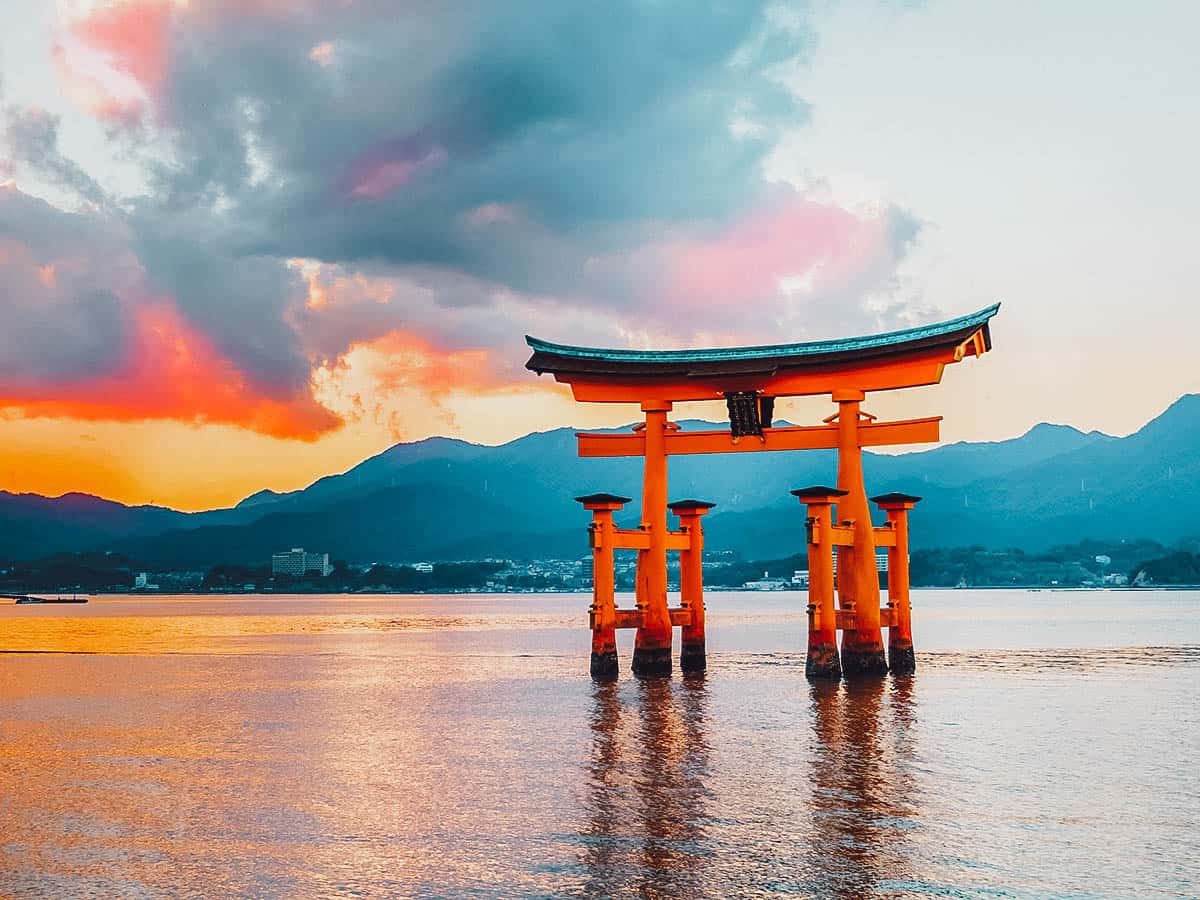
Photo by cowardlion via Shutterstock
Motonosumi Inari Shrine
Motonosumi Inari Shrine is a Shinto shrine famous for its spectacular series of bright red torii gates. Located in Yamaguchi prefecture, 123 torii gates are aligned like a tunnel and lead visitors towards a cliff facing the Sea of Japan. If you want striking Instagram photos, then this is a great place to visit on a day trip.
Located three hours away from Hiroshima, Motonosumi Inari Shrine isn’t near any major towns so it may be best to rent a car and drive there yourself. You can refer to this article for information on driving in Japan.
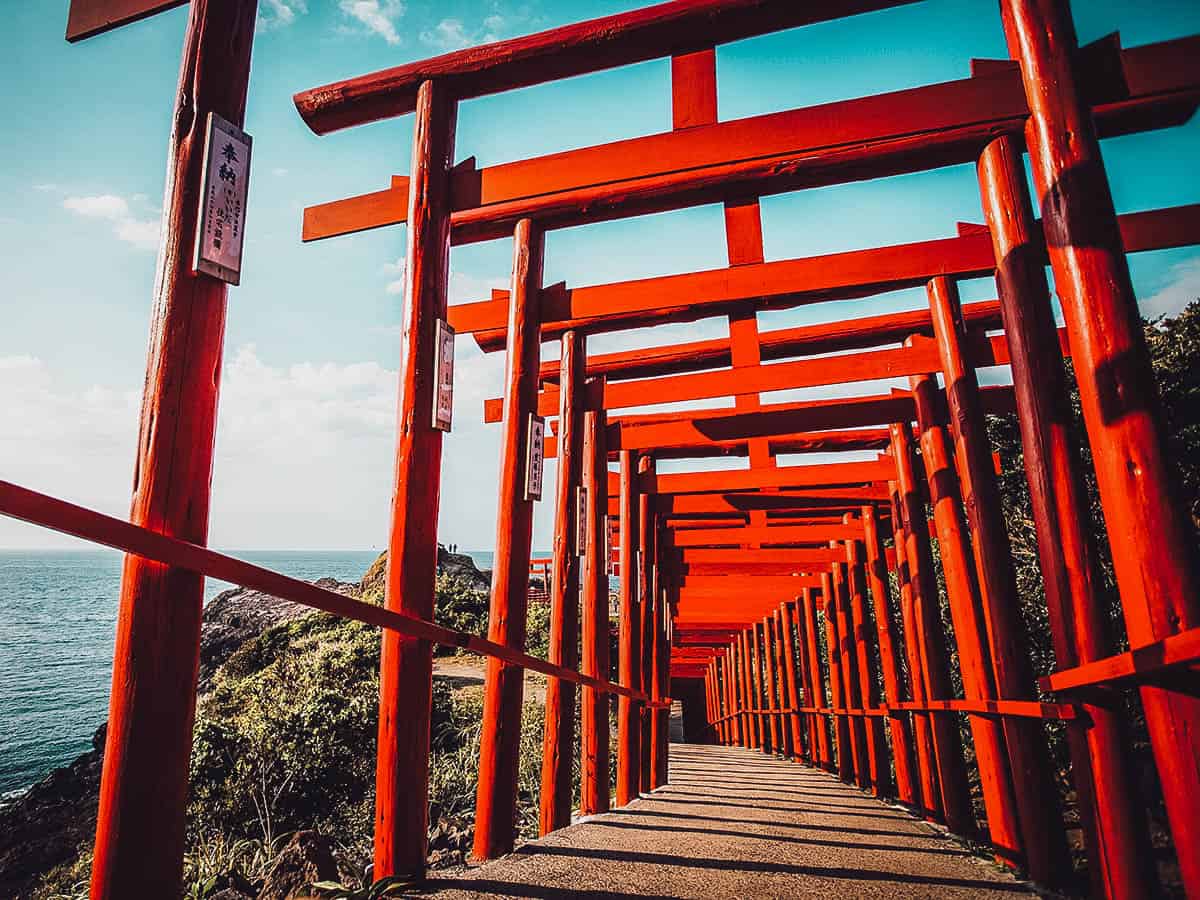
Photo by journeykei via Shutterstock
Tsunoshima Bridge
If you’re going to rent a car and drive to Motonosumi Inari Shrine, then you may well continue on to Tsunoshima Bridge.
Located less than an hour’s drive from Motonosumi Inari Shrine, Tsunoshima Bridge is the second longest bridge in Japan. It measures 1,780 meters (5,840 ft) in length and connects the mainland with Tsunoshima Island via a scenic drive with clear views of the ocean on either side.
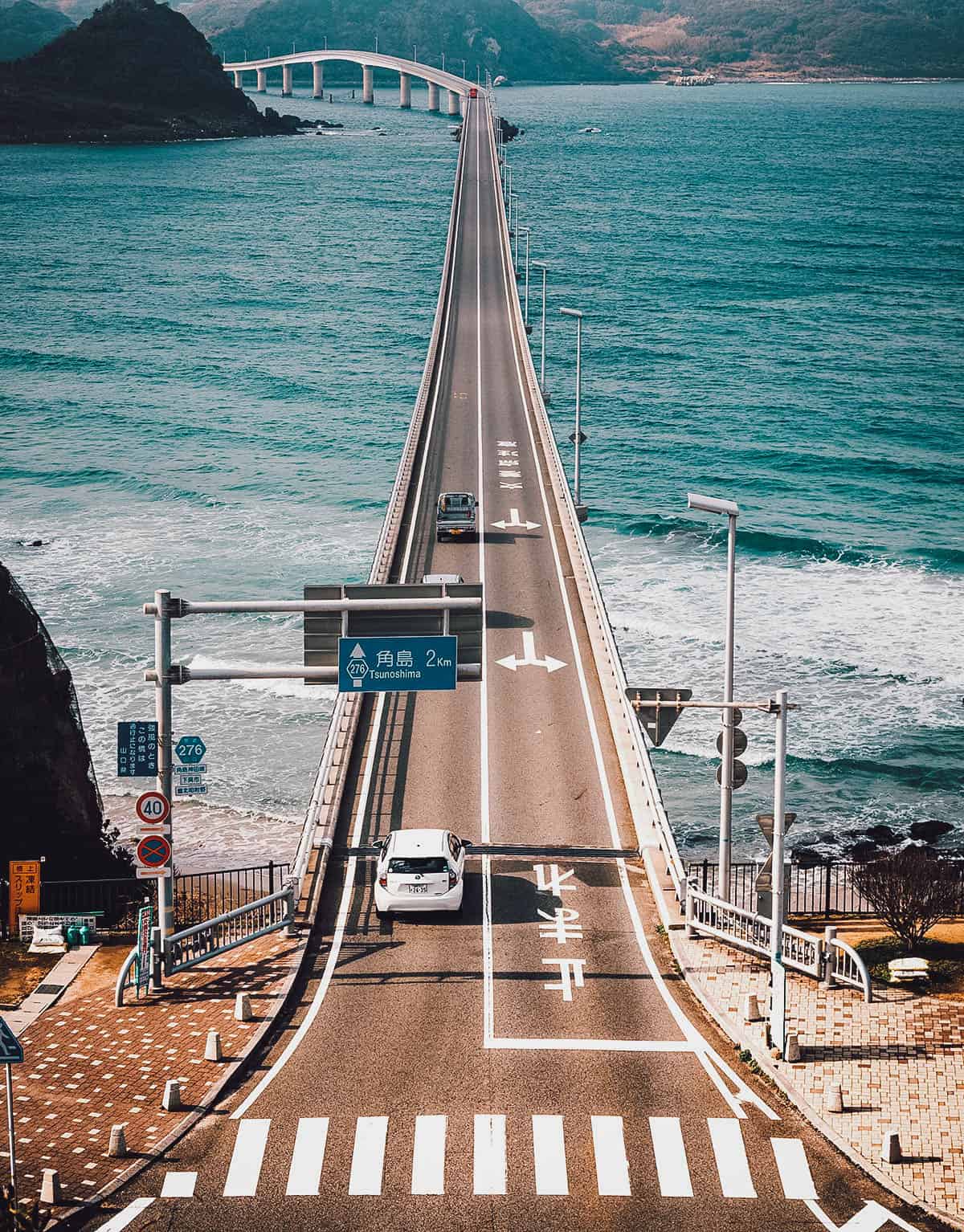
Photo by Samuel Yeo via Shutterstock
Sandankyo Gorge
If hiking on Miyajima Island isn’t enough to satisfy your thirst for nature, then you may want to spend the day at Sandankyo Gorge.
Located about 1.5 hours northwest of Hiroshima, Sandankyo Gorge is a lush forested area offering plenty of trekking and kayaking opportunities. You’ll have several routes to choose from but the full hike takes around five hours to complete. You can refer to this excellent article for more information.
Sandankyo Gorge is closer to the city than the previous two destinations, but buses from Hiroshima Bus Center are limited (click here for a schedule). Going by bus puts you on a tighter schedule so it may be best to rent a car and driving there yourself.
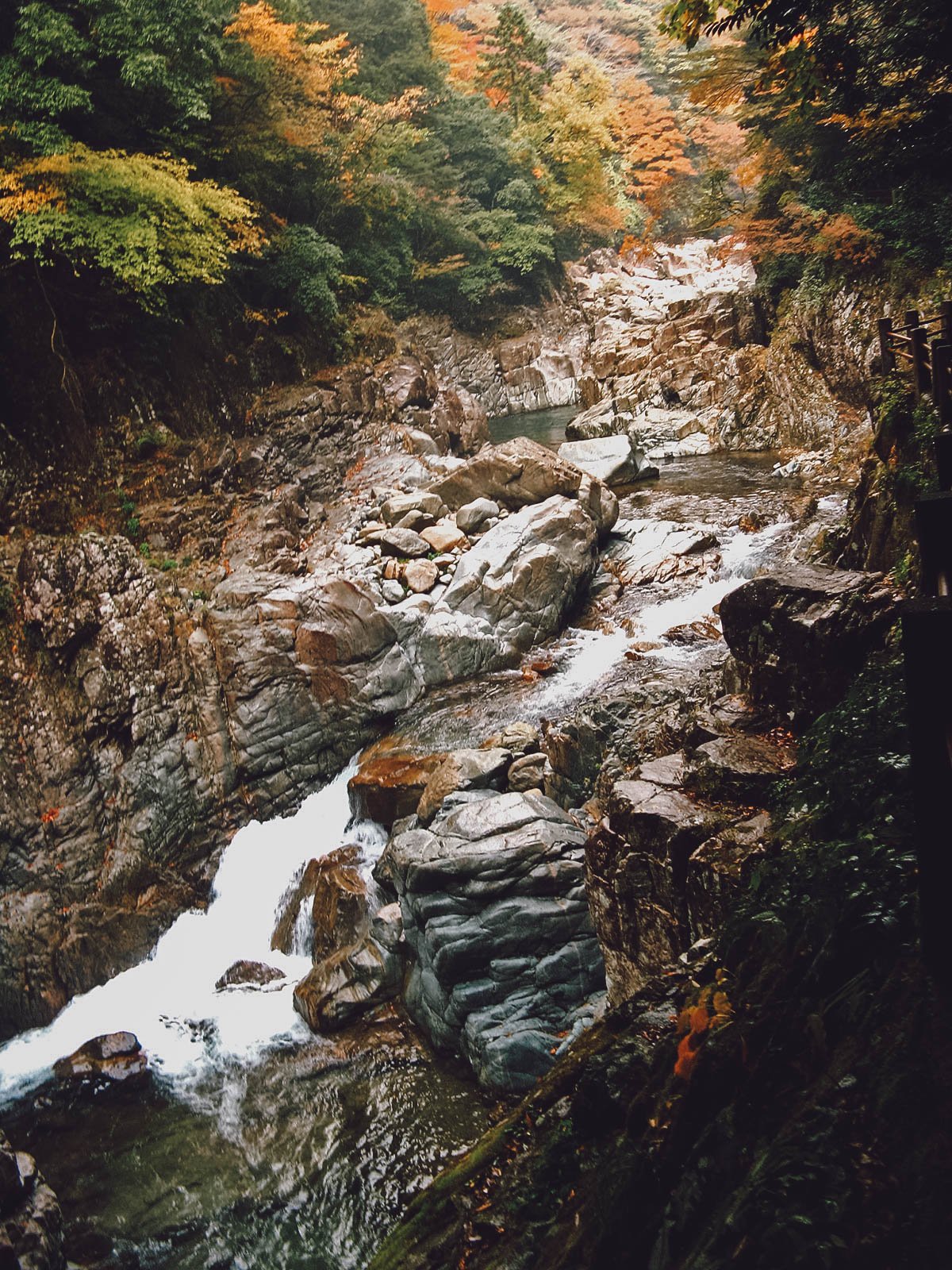
“三段峡” by kagawa_ymg, used under CC BY 2.0 / Processed in Photoshop and Lightroom
VISIT HIROSHIMA FAQs
Is Hiroshima worth visiting?
Absolutely. I wasn’t expecting much but it turned out to be one of my favorite destinations in Japan. Hiroshima City on its own is worth a quick stop but pair it with Miyajima Island and it becomes a must-visit.
How many days should I spend in Hiroshima?
A minimum of two days would be ideal – one to explore Hiroshima City and the other to do some hiking on Miyajima Island.
Is it easy to get around in Hiroshima?
Yes. Like Nagasaki, Hiroshima has an extensive tram system called the Hiroden. It’ll take you to many of the city’s top tourist attractions, including the ferry port to Miyajima Island.
I usually get stored-value IC cards when I visit Japan but there are a few tourist passes you can get to save on transportation. The one-day Hiroden Pass, for example, will give you unlimited rides on Hiroshima’s tram network for one calendar day. You can even get a version that includes round-trip ferry rides to Miyajima.
If you plan on staying longer, then the Visit Hiroshima Tourist Pass is another option. Not only will it give you unlimited rides on trams, buses, and ferries for 1-3 days, but you’ll also get a voucher book with coupons to sightseeing spots and restaurants throughout the city.
Tourists with a valid countrywide JR Pass or a JR West regional pass will be pleased to learn that they can use it to ride the Hiroshima Sightseeing Loop Bus (Meipuru-pu) for free.
Should I spend the night on Miyajima Island?
Yes! You can see Miyajima’s highlights in a day but if you have the time, then it would be nice to stay the night and enjoy the island in its quieter hours. Like many popular day trip destinations, you’ll appreciate the island more after the tourists have gone (or before they arrive).
THE FINAL SAY
Hiroshima isn’t on the usual tourist trail in Japan but it should be. The Peace Memorial Museum and Istukushima Shrine are must-do experiences, plus there’s enough in Hiroshima – like the food and hiking on Miyajima – to merit return visits.
I, for one, am looking forward to going back!
Disclosure
This Hiroshima travel guide contains affiliate links, meaning we’ll earn a small commission if you make a booking or purchase at no extra cost to you. As always, we only recommend products and services that we use ourselves and firmly believe in. We really appreciate your support as this helps us make more of these free travel guides. Arigato gozaimasu!

